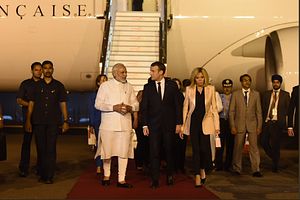French President Emmanuel Macron was on a four-day visit to India earlier this week, with both sides trying to elevate the India-France strategic relationship. The bilateral partnership covers an entire gamut of issues from defense, civil nuclear, and space to climate change, clean energy, and urbanization, and India and France signed 14 agreements. But what was of particular importance on the defense side were those on outer space and maritime security in the Indian Ocean.
On outer space, the two countries identified nine specific areas in the India-France Joint Vision for Space Cooperation of which a few including high resolution earth observation, space domain and situational awareness, satellite navigation, space transportation, and human exploration, stand out. Space Situational Awareness (SSA) and high resolution earth observation are especially relevant in the context of the growing concerns around maritime security and the Indian Ocean.
The two countries have shared concerns on a number of issues, including, as they framed it, “maritime traffic security, especially in the Horn of Africa; respect of international law by all States, in particular freedom of navigation and overflight; fight against organized crime, trafficking, including in weapons of mass destruction, smuggling and illegal fishing.”
Recognizing the need to develop a joint action plan, the two sides signed a Joint Strategic Vision for Cooperation in the Indian Ocean Region. A practical joint action in the area of maritime surveillance around Indian Ocean waters would at the very least call for a clearer understanding of the maritime environment that they are operating in and this has pushed both India and France to increase sharing of information on the emerging maritime scenario in the Indian Ocean.
The MoU signed between the two space agencies foresees them joining hands to design and develop “products and techniques, including those involving Automatic Identification System, to monitor and protect assets in land and sea.” This, the two sides believe, will significantly boost maritime domain awareness in the region. Given the growing reliance and vulnerabilities that exist in the outer space domain, the two space agencies also agreed to develop a cooperative agenda that will protect their space assets, by also developing infrastructure that is necessary to create a broader engagement on SSA.
Underlying all these practical steps is the shared strategic vision, particularly driven by the strategic uncertainties around China’s rise and its growing assertiveness. The two share a common strategic objective of “establish[ing] an open, inclusive and transparent cooperation architecture, with the aim of delivering to all associated with the region, peace, security and prosperity.”
Modi, during his meeting with Macron said that both sides believed in the importance of the Indian Ocean for the global community, while Macron in his own remarks acknowledged the importance of the Indian Ocean for the stability of the entire region. Most significantly, India and France agreed to reciprocal access to each other’s naval facilities to military facilities. France has facilities in the island of La Réunion, Mayotte, and the French Southern and Atlantic Lands. Indian access to French military facilities will help India spread its reach and influence, especially in western Indian Ocean.
This is similar to the understanding that India had earlier reached with the United States with the signing of LEMOA. That agreement occasioned a lot of criticism in India, with commentators suggesting that India was bargaining away its precious “strategic autonomy.” Indeed, that agreement was delayed for years precisely because of the fear of such criticism.
But the agreement with France has largely received a positive reception in the Indian media. The difference between the treatment of these two agreements indicates a clear evidence of the continuing opposition among sections of the Indian elite to any closer ties with Washington. Indeed, precisely for this reason, France may be a good supplement to India’s strategic partnerships. It should also be remembered that France has generally been supportive of critical issues of concern to India, including India’s nuclear weapons program (before it acquired its current level of legitimacy).
On the other hand, the limitations of the partnership should also be kept in mind. If France has not received as much importance in New Delhi as some others such as the United States, despite France’s well-acknowledged sympathy for India’s strategic concerns, the reason has been mostly due to France’s relatively limited capacity. The current bonhomie overlooks this old and unchanged limitation: though France can help India, its own remaining weakness will likely not allow Paris to become a major source of strategic support to New Delhi. But in these troubled times, one more supporter is surely welcome.

































